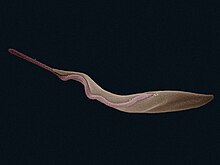Excavata
| Excavata | ||||||
|---|---|---|---|---|---|---|
| Systematik | ||||||
| ||||||
| Wissenschaftlicher Name | ||||||
| Excavata | ||||||
| Cavalier-Smith, 2002, emend. Simpson, 2003 |
Die Excavata sind ein Taxon, das als super-group zu den Eukaryoten (Lebewesen mit Zellkern) gestellt wird. Zu ihnen gehören ausschließlich einzellige Organismen, die ausnahmslos begeißelt sind. Innerhalb der Euglenozoa gibt es Formen mit Chloroplasten, die entsprechend Photosynthese betreiben.
Merkmale
Namensgebend für die einzelligen Excavata ist der typisch geformte Zellmund (Cytostom) mit einer ausgeprägten Mundgrube („excavater“ Typ), der bei den meisten Arten vorhanden ist. Dieser kann allerdings auch sekundär wieder reduziert worden sein. Die Mundgrube wird von den meisten Arten genutzt, um Nahrungspartikel einzufangen und per Phagozytose in die Zelle aufzunehmen.[1]
Die Euglenozoa besitzen im Stammartmuster Chloroplasten und sind somit als einzige Gruppe innerhalb der Excavata zur Photosynthese befähigt. Die Chloroplasten wurden allerdings bei einer Reihe von Taxa mit parasitärer Lebensweise wieder reduziert.[1]
Systematik

Thomas Cavalier-Smith (2017).

Adl u. a. gliedern die Eukaryoten in drei Untergruppen, die Diaphoretickes, Amorphea und eben die Excavata.[2] Als einzige der Untergruppen enthalten die Excavata nur eine sogenannte Obergruppe. Sie sind stattdessen in sieben Gruppen ohne weitere Rangstufen untergliedert:[1]
- Fornicata
- Malawimonas
- Parabasalia
- Preaxostyla
- Jakobida
- Heterolobosea
- Euglenozoa
Voneinander unabhängige molekulargenetische Untersuchungen belegten 2008, dass die Gattung Stephanopogon, die lange als in unsicherer Position bei den Eukaryoten geführt wurde, das Schwestertaxon der Gattung Percolomonas ist (bei Adl noch Vahlkampfiidae). Die aus den beiden Gattungen gebildete Klade wiederum ist das Schwestertaxon der Heterolobosea. Cavalier-Smith zufolge stellen die beiden Kladen in ihrer Gesamtheit die sogenannten Percolozoa als Schwester der Euglenozoa.[3][4]
Weblinks
Nachweise
- ↑ a b c Sina M. Adl, Alastair G. B. Simpson, Mark A. Farmer, Robert A. Andersen, O. Roger Anderson, John A. Barta, Samual S. Bowser, Guy Bragerolle, Robert A. Fensome, Suzanne Fredericq, Timothy Y. James, Sergei Karpov, Paul Kugrens, John Krug, Christopher E. Lane, Louise A. Lewis, Jean Lodge, Denis H. Lynn, David G. Mann, Richard M. McCourt, Leonel Mendoza, Øjvind Moestrup, Sharon E. Mozley-Standridge, Thomas A. Nerad, Carol A. Shearer, Alexey V. Smirnov, Frederick W. Spiegel, Max F. J. R. Taylor: The New Higher Level Classification of Eukaryotes with Emphasis on the Taxonomy of Protists. The Journal of Eukaryotic Microbiology 52 (5), 2005; Seiten 399–451. PMID 16248873. doi:10.1111/j.1550-7408.2005.00053.x.
- ↑ Adl, S. M., Simpson, A. G. B., Lane, C. E., Lukeš, J., Bass, D., Bowser, S. S., Brown, M. W., Burki, F., Dunthorn, M., Hampl, V., Heiss, A., Hoppenrath, M., Lara, E., le Gall, L., Lynn, D. H., McManus, H., Mitchell, E. A. D., Mozley-Stanridge, S. E., Parfrey, L. W., Pawlowski, J., Rueckert, S., Shadwick, L., Schoch, C. L., Smirnov, A. and Spiegel, F. W.: The Revised Classification of Eukaryotes. Journal of Eukaryotic Microbiology, 59: 429–514, 2012, PDF Online
- ↑ Naoji Yubuki, Brian S. Leander: Ultrastructure and molecular phylogeny of Stephanopogon minuta: An enigmatic microeukaryote from marine interstitial environments, In: European Journal of Protistology 44, 2008, S. 241–253
- ↑ Thomas Cavalier-Smith, Sergey Nikolaev: The Zooflagellates Stephanopogon and Percolomonas are a Clade (Class Percolatea: Phylum Percolozoa) In: Journal of Eukaryotic Microbiology, 55(6), S. 501–509, 2008
Auf dieser Seite verwendete Medien
Two trophozoites of Trichomonas vaginalis obtained from in vitro culture. Smear was stained with Giemsa.
Autor/Urheber: Zephyris, Lizenz: CC BY-SA 3.0
False colour SEM of procyclic form (found in the tsetse fly host in the gut) Trypanosoma brucei. 84 pixels/μm. The cell body is shown in orange and the flagellum is in red.
Autor/Urheber: Thomas Cavalier-Smith (caption slightly moved, digitylly enhanced), Lizenz: CC BY-SA 4.0
Cytoskeletal innovations during loukozoa origins. Ancestral condition in loukozoa summarized as represented by Malawimonas. Upper shows the whole cell seen from the right with the feeding groove tilted obliquely to show left and right mt roots (R1, R2) that support feeding groove rims and floor. Younger anterior cilium (C2) with oar-like beat and older posterior cilium (C1) undulating from base to tip simultaneously propel the cell forward (arrow) and waft food into the groove for ingestion. Lower diagram views the cell apex from the ventral side (so the cell’s right is on the left) to show mt arrays (colour: mt bands R1–R3; plus a dorsal fan of diverging mts that support the cell’s dorsal surface) and associated fibrous supports (black: A–C, I). The orthogonal centrioles (anterior A, posterior P) are interconnected by asymmetric linkers and in loukozoa (left) a dorsal mt fan and anterior left mt band (R3) connect C2s to the apical dorsal plasma membrane. R3 is developmental precursor of R1. The ancestral loukozoan interposed novel alveoli between the plasma membrane and dorsal fan, which split into a right bypassing mt band (BB) and numerous single, diverging subpellicular mts attached to alveolar inner faces. The text argues that developmentally and evolutionarily the singlet root (S, brown) is a specialised R2 subcomponent, not a third posterior root as traditionally assumed. Dorsal fan and apical mts are actually longitudinal (as shown for BB only); the purple line symbolises a cross section of their mt arrays.


